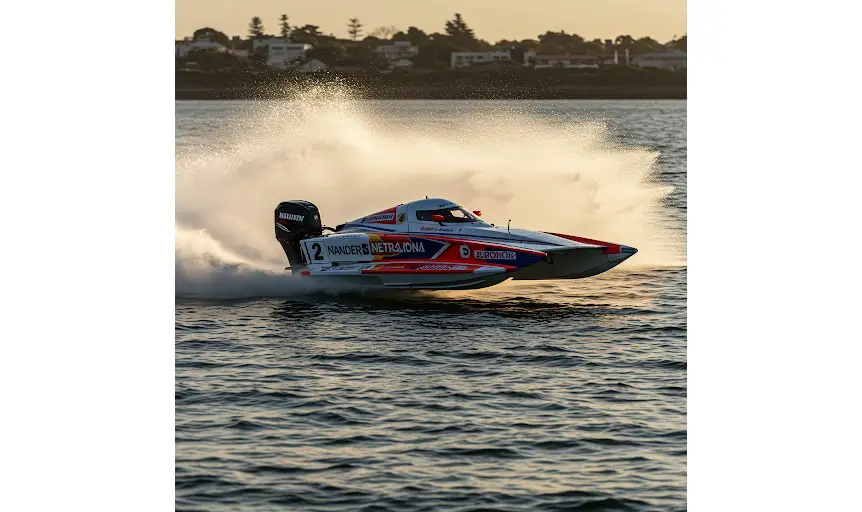
The Thrilling World of F1 Powerboat Racing: Speed, Strategy, and Global Impact
F1 Powerboat Racing is one of the most exhilarating motorsports in the world. It combines speed, precision, and international flair. Fans often compare it to Formula One car racing, but on water. Unlike car racing, however, the challenges of waves, wind, and water add unique dynamics. Across continents, the sport draws crowds with high-speed action and cutting-edge technology. F1 Powerboat Racing captures the hearts of fans through drama, danger, and dazzling skill.
The Origin and History of F1 Powerboat Racing
Powerboat racing dates back to the early 1900s. Wealthy enthusiasts in Europe and the United States held informal races. These early contests featured wooden hulls and modest engines. The sport grew quickly as engine technology advanced.
The first official offshore powerboat race occurred in 1903. It was held from Paris to Trouville, France. By the 1920s, powerboat racing had formal rules and growing international attention. Over the decades, hull design improved, engines became more powerful, and competition intensified.
F1 Powerboat Racing, as a distinct discipline, began in 1981. The Union Internationale Motonautique (UIM) organized the first World Championship. The sport followed a Grand Prix format, similar to Formula One. Races took place in major cities, often in protected bays or rivers.
Through the 1980s and 1990s, the sport gained fame. Sponsorships increased. Media coverage spread across Europe, Asia, and the Middle East. Legendary drivers emerged, such as Guido Cappellini and Jonathan Jones. Their rivalries added drama to the growing fan base.
Global Popularity and Geographic Spread
Today, F1 Powerboat Racing is truly global. Races occur on almost every continent. The sport has a strong presence in the United Arab Emirates, Italy, China, and Portugal. These countries regularly host Grand Prix events.
In Asia, the sport draws huge crowds in cities like Shanghai and Liuzhou. Middle Eastern cities such as Sharjah and Abu Dhabi are key hosts. These events often attract tens of thousands of spectators. In Europe, lakes and rivers in countries like France, Norway, and Italy provide ideal venues.
F1 Powerboat Racing enjoys television coverage in over 100 countries. Digital platforms stream races live, expanding the audience further. Social media also plays a major role. Fans can follow teams, watch highlights, and engage with drivers.
The sport’s appeal crosses cultural and national boundaries. Its combination of speed, danger, and high technology fascinates people. Governments often support the races to promote tourism and international prestige.
Amateur and Youth Participation Worldwide
While F1 Powerboat Racing is elite, amateur levels thrive globally. Local clubs organize races for beginners. These events use smaller, less powerful boats. Safety is a top priority, and young racers receive extensive training.
Many countries support youth development programs. In Europe, programs in Italy and France introduce children to powerboat racing. The UIM also supports youth training through its “Youth and Junior Development” program. These initiatives teach navigation, safety, and racing techniques.
In the United States, amateur leagues allow adults and teens to participate. They compete in regional events with strict safety standards. Boats in these leagues have speed limits to ensure fair competition.
Schools and summer camps sometimes offer powerboating courses. In Scandinavia, water sports are part of many school curriculums. Students learn about boat mechanics, water safety, and navigation.
These grassroots efforts build a pipeline of talent. Young racers often transition to professional circuits. Many current F1 Powerboat Racing stars started in youth leagues.
Professional Leagues and Organizations
The UIM is the global governing body for F1 Powerboat Racing. It sets the rules, certifies races, and ensures safety standards. The UIM F1H2O World Championship is the sport’s top professional series.
This championship features elite teams from around the world. Teams include drivers, mechanics, and engineers. Each race weekend includes practice sessions, qualifying rounds, and the final race.
Prominent teams include Victory Team (UAE), CTIC F1 Shenzhen China Team, and Team Abu Dhabi. These teams invest heavily in boat design and driver training. Professional races feature tight turns, high speeds, and intense rivalries.
Besides the main championship, other leagues exist. In Europe, regional championships like the F2 and F4 circuits serve as feeders. These lower divisions allow drivers to gain experience and visibility.
Asia also has growing professional leagues. China, India, and Thailand host national championships. These events often receive local government support and media attention.
Political and Social Significance
F1 Powerboat Racing carries political weight in some regions. Hosting a race boosts a city’s international image. Countries use the sport to showcase development, modernity, and tourism.
For example, the UAE invests millions in marine sports. It positions cities like Abu Dhabi and Sharjah as global sporting hubs. These races attract luxury tourists, sponsors, and global media.
Socially, the sport promotes water safety and marine awareness. Many events include environmental campaigns. Organizers educate the public on ocean conservation and safe boating practices.
F1 Powerboat Racing also brings communities together. Events often feature food festivals, concerts, and cultural displays. Locals benefit from tourism, while fans enjoy immersive experiences.
In some cases, races foster international cooperation. Countries collaborate on logistics, regulations, and safety. These efforts build diplomatic goodwill and technical exchange.
Rules and Regulations of the Sport
The rules of F1 Powerboat Racing ensure fair and safe competition. The UIM enforces strict guidelines. Each team must meet technical and safety requirements.
Boats are limited to a weight of around 513 kilograms. Engines must conform to UIM standards. Each boat can reach speeds of over 220 km/h (136 mph).
The race format includes free practice, qualifying, and the main event. Qualifying determines the starting grid. Races usually last about 45 minutes. Drivers complete multiple laps around a buoy-marked course.
Each race circuit is different. Some feature tight turns and short straights. Others offer more open water and longer laps. Racers must adapt their strategy to the layout.
Drivers earn points based on finishing position. The season’s champion is the driver with the most points. There is also a team championship based on combined driver results.
Safety is paramount. Drivers wear reinforced suits and helmets. Cockpits are crash-resistant and have oxygen systems. Rescue teams are on standby at every event.
Penalties are given for unsafe behavior, false starts, or missing buoys. Video review and on-site referees enforce these rules.
Weather also plays a key role. Officials monitor wind and wave conditions. Races may be delayed or canceled for safety.
The Future of F1 Powerboat Racing
The sport continues to grow in reach and technology. Electric and hybrid powerboats are under development. These innovations aim to reduce environmental impact.
New countries express interest in hosting races. Emerging markets like Vietnam, Brazil, and South Africa explore race logistics. This trend could further globalize the sport.
Media partnerships expand the fan base. Livestreaming, social media, and virtual reality bring the sport closer to viewers. Fans can follow races in real time from anywhere in the world.
Women are also making strides in the sport. Female drivers compete at all levels. Their presence inspires a more diverse generation of racers.
F1 Powerboat Racing may also become part of multi-sport events. Discussions are ongoing to include it in events like the Asian Games.
Conclusion
F1 Powerboat Racing is more than just high-speed boats. It is a global spectacle, a community, and a symbol of innovation. Its rich history, international presence, and cultural significance make it a standout sport.
From amateur leagues to elite championships, the sport unites fans worldwide. Its thrilling races and technical mastery offer unmatched excitement. Governments, communities, and fans all find value in its presence.
As the sport evolves, its impact will likely deepen. F1 Powerboat Racing is poised to reach even greater heights in the years to come.





